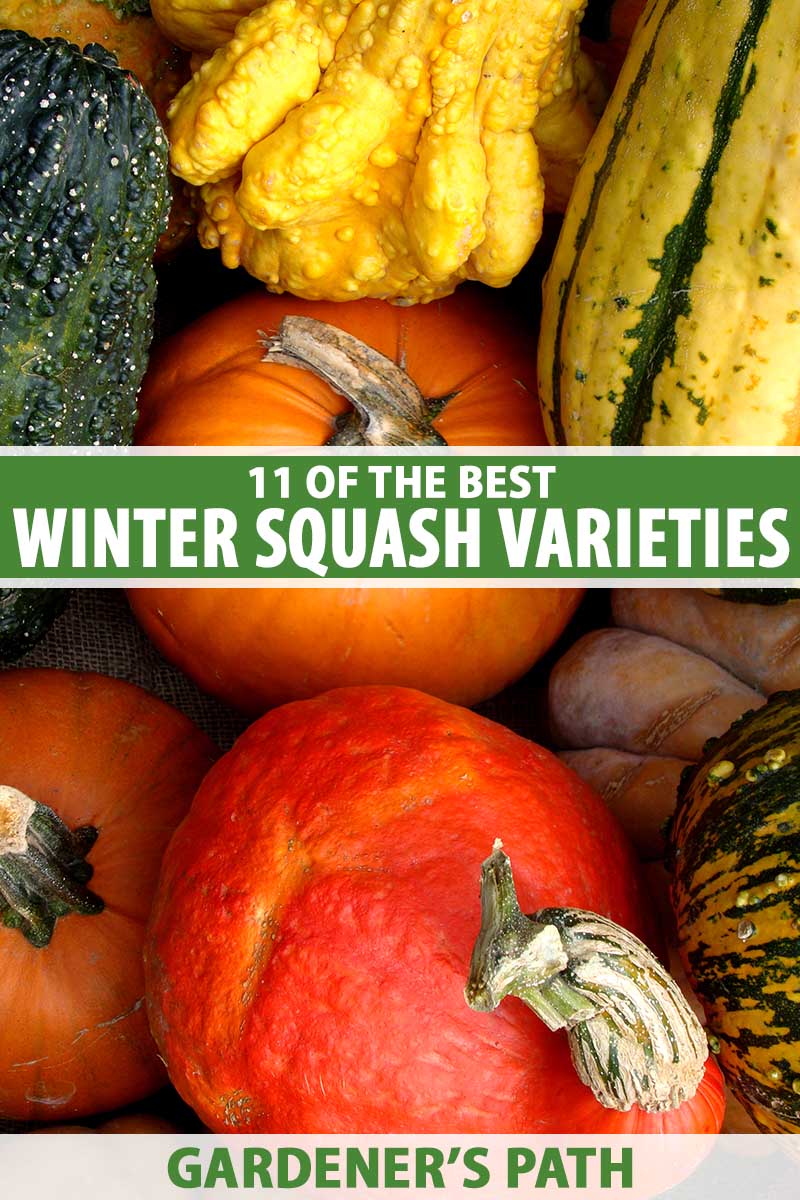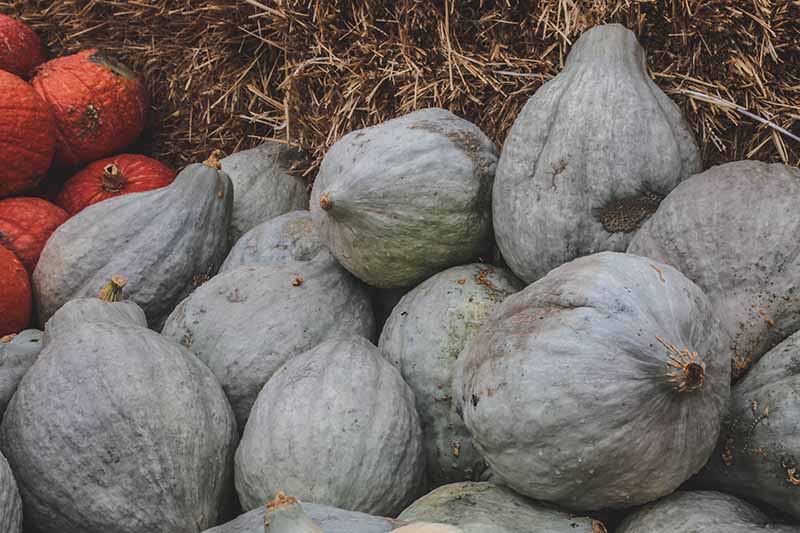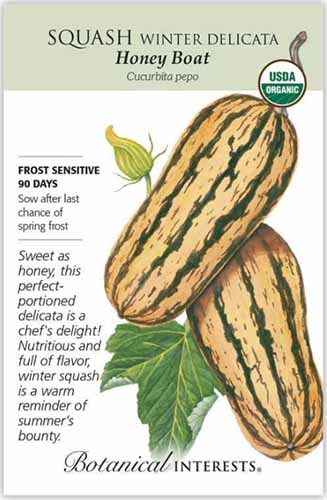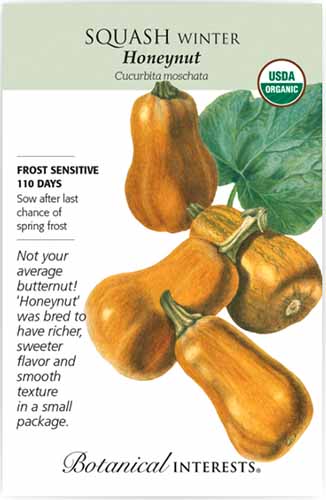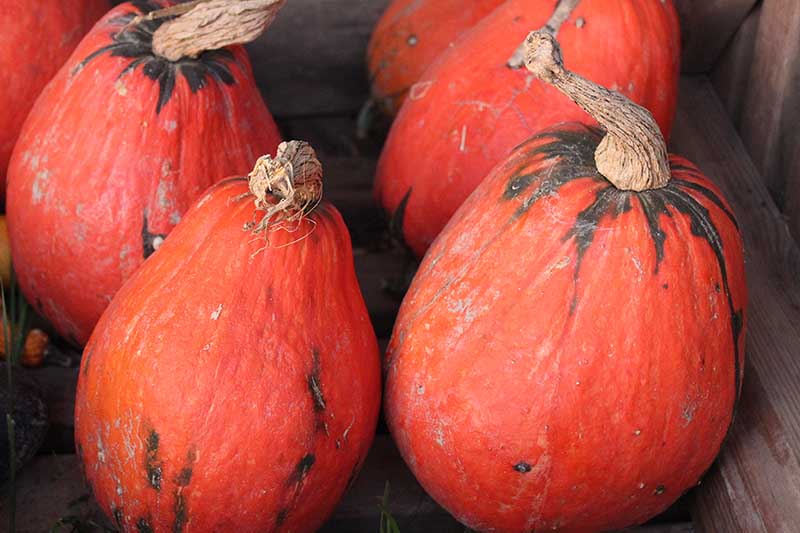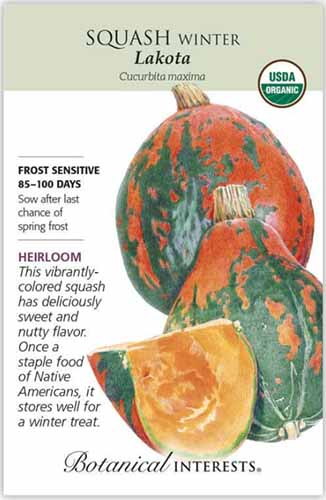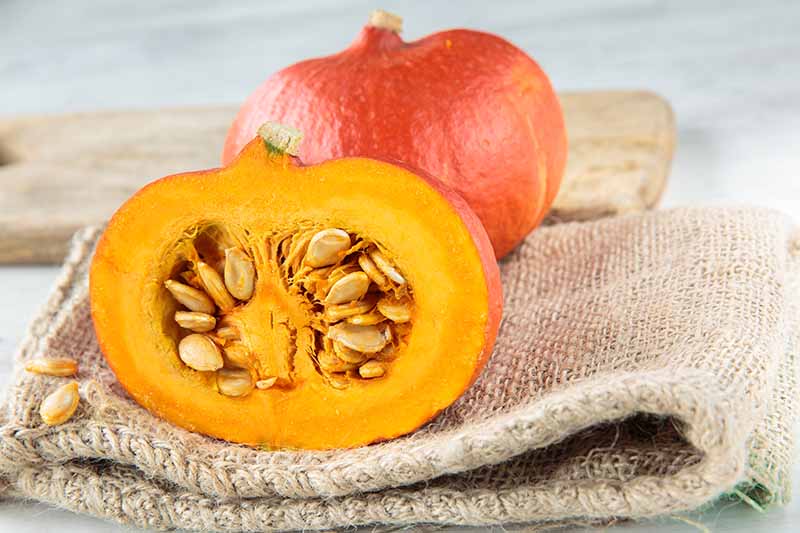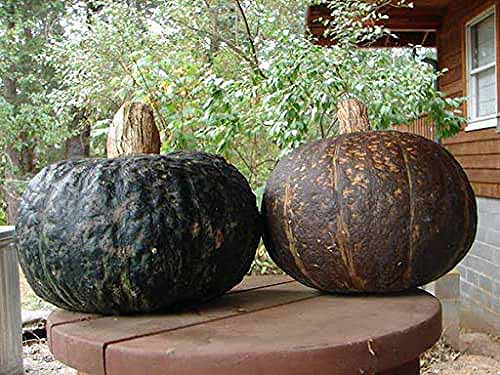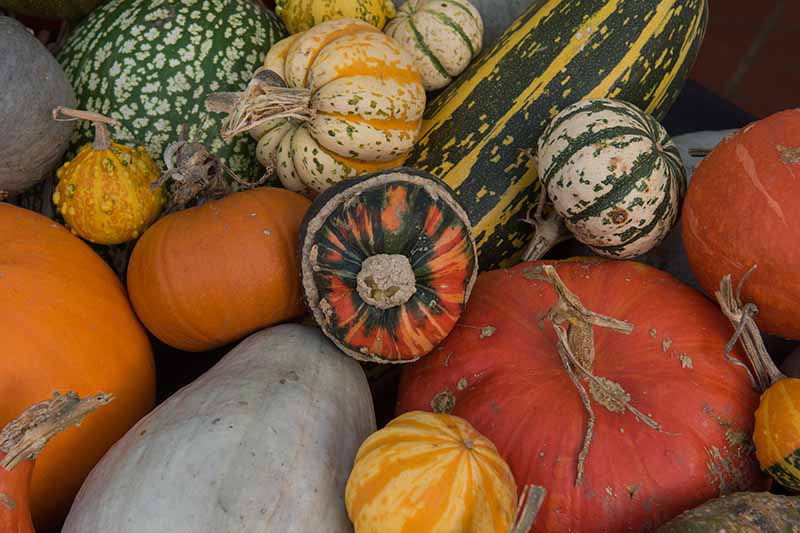So, treat your future self to a feast – pick winter squash varieties that will fit your growing season and the dimensions of your garden, and please your palate. Winter squash is one of my favorite vegetables, both to eat and to grow. And although the payoff is delayed, since you have to be patient throughout the summer and let your crop mature, what a payoff it is! We link to vendors to help you find relevant products. If you buy from one of our links, we may earn a commission. So, I’ve put together this roundup of some of the best winter squash varieties around, making sure to include something for everyone when it comes to plant size, days to maturity, taste, and texture. I’ll also be sure to let you know what species each of these cultivars is, in case you want to save seeds. Here’s a peek at my list: Each plant produces up to fifteen egg-shaped squash that weigh in at one and a half to two pounds each. They measure three and a half to four inches wide, and four to five inches tall. ‘Angel Hair’ has a dark yellow rind enclosing light yellow flesh that shreds into strands of fine “spaghetti.” I like to enjoy the mild but crisp flesh of this variety roasted in the oven, drizzled with a little olive oil, and topped with fresh goat cheese and oregano. ‘Angel Hair’ A cultivar of C. pepo, since these squash are on the small size, the long vines of the plant are easy to trellis. Expect your first harvest in 88 days. You’ll find ‘Angel Hair’ available for purchase in packs of eight seeds at Botanical Interests.
2. Blue Hubbard
If you want to grow an ample winter squash that will keep for a long time and provide you with many culinary uses, you might want to include ‘Blue Hubbard’ in your garden. A cultivar of C. maxima, the fruits of ‘Blue Hubbard’ are teardrop shaped with pale blue-gray skin, and they weigh 12 to 40 pounds at maturity. This winter squash has shallow ribs and is somewhat bumpy. Inside the hard blue shell, this cultivar has yellow flesh that is sweet and velvety with a fine texture, making ‘Blue Hubbard’ great for pies, soups, and roasting. ‘Blue Hubbard’ is open pollinated, with long vines that need 100 to 110 days to bring a crop to maturity. This variety is excellent for storage, keeping for six months or more. ‘Blue Hubbard’ You’ll find ‘Blue Hubbard’ seeds available in an assortment of packet sizes from Mountain Valley Seed Company via True Leaf Market.
3. Burgess Buttercup
‘Burgess Buttercup’ is a variety of C. maxima that has a dark green, thin, hard rind with faint light green stripes, and a flattened top. There is a “button” on the blossom end of each squash. This winter squash was named after the seed purveyors that introduced the variety in 1952, the Burgess Seed and Plant Company. Each plant bears three to four fruits that weigh in at three to five pounds each, and have a very sweet and slightly nutty flavor. The flesh of ‘Burgess Buttercup’ is golden to orange colored and free of fibers, with a dry texture. Great for more compact gardens, this plant grows in a bush form and produces a harvest in 85 to 100 days. ‘Burgess Buttercup’ In storage, ‘Burgess Buttercup’ is a medium-long keeper. You’ll find ‘Burgess Buttercup’ seeds available for purchase in an assortment of package sizes at True Leaf Market.
4. Cushaw Green Striped
‘Cushaw Green Striped’ is an heirloom variety of C. mixta that boasts both heat tolerance and pest resistance. This cultivar was included in the Slow Food Foundation’s Ark of Taste because of its historical significance among many tribal peoples of the Southwestern United States. It is also used in traditional recipes from Louisiana, and in the Southern Appalachian region it often takes the place of honor in pumpkin pie recipes. In Tennessee, home cooks use this variety to make “cushaw butter,” a twist on pumpkin butter. ‘Cushaw Green Striped’ produces large crookneck winter squashes that are white with green stripes, weighing in at 10 to 15 pounds each, and reaching up to 20 inches in length. Sometimes called “Tennessee sweet potato” or “sweet potato pumpkin,” this variety has mild, light yellow flesh that is moist and has a good texture that is just slightly grainy. However, in exchange for a less creamy texture, you’re going to get a massive amount of squash. The vines of this heirloom are vigorous, heavy yielding, and resistant to squash vine borers and downy mildew, making this plant a great option for those who have struggled to produce a winter squash harvest in the past because of pests or disease. ‘Cushaw Green Striped’ Expect your harvest in 95 days. You’ll find ‘Cushaw Green Striped’ seeds available for purchase in an array of package sizes at True Leaf Market.
5. Futsu Black
‘Futsu Black’ is a C. moschata cultivar from Japan that is a favorite of many gardeners. This productive variety produces three to five fruits per plant, each weighing three to five pounds each. Fruits are round and deeply ribbed with warty skin. Also known as ‘Futtsu Black Early,’ this squash changes from black to chestnut colored while in storage and develops a “bloom” on its skin, making it even more ornamental. Before you transform your ‘Futsu Black’ harvest into food, you might want to take advantage of its unique appearance as part of your autumnal decor. Inside that distinctive skin you’ll find bright orange flesh that has a creamy texture. The flesh of ‘Black Futsu’ has a fruity flavor at harvest, and after storage it becomes nuttier. The skin is edible, and since it’s thin, this variety is not suited to long term storage. In the kitchen, ‘Black Futsu’ is delicious raw, roasted, and in purees and pies. ‘Futsu Black’ Vines reach three to five feet long, and provide a harvest in 105 days.
6. Honey Boat
Sometimes a sweet treat can start from a healthy foundation, and such is the case with ‘Honey Boat.’ This cultivar was developed by Jim Baggett at Oregon State University in 1988. An open-pollinated delicata, it is a variety of C. pepo. Oblong fruits are six to eight inches long and three inches across, weighing about a pound each, and making trellising easy. ‘Honey Boat’ has yellowish tan skin with green stripes. Inside, its flesh is yellow-orange with a smooth texture. With a flavor that is both sweet and nutty, ‘Honey Boat’ is considered one of the sweetest winter squashes. It has a large seed cavity so it’s good for using as a “boat” for whatever filling you might choose, even a drizzling of honey or maple syrup. ‘Honey Boat’ The vines of these plants grow to be nine to 12 feet long, producing a harvest in 90 to 100 days. ‘Honey Boat’ doesn’t need to be cured after harvesting, but it keeps well, nonetheless. You’ll find ‘Honey Boat’ seeds available for purchase in 1.5-gram packets at Botanical Interests.
7. Honeynut
‘Honeynut’ hasn’t yet gained the status of an heirloom cultivar, but it has prestige for another reason. This partnership started when Mazourek was touring Barber’s restaurant, Blue Hill at Stone Barns. The plant breeder entered the restaurant kitchen and Barber greeted him with a challenge, asking him why, if he was a plant breeder, he couldn’t make a butternut squash that tasted better – and while he was at it, why not make it smaller, too? Mazourek accepted the challenge, and ‘Honeynut’ was born. As promised, ‘Honeynut’ is both smaller and tastier than a standard butternut squash. Squat fruits are four to five inches long, and weigh in at a half a pound to a pound each. This cultivar of C. moschata is pretty enough to grow for decoration only. Starting out green, when ripe, ‘Honeynut’ turns a rich terra cotta color. However, it would be a shame to keep this variety in your home without tasting it. ‘Honeynut’ is deliciously sweet with a creamy texture, and a thin skin that can be eaten. Compact vines are 24 to 36 inches long, and have good resistance to powdery mildew and squash vine borers. And because of the fruits’ diminutive size, the plants are easy to grow vertically on a trellis. ‘Honeynut’ Expect a harvest in 110 days, with an average of five fruits per plant. ‘Honeynut’ will store for up to six months. You’ll find ‘Honeynut’ available for purchase in packs of ten seeds at Botanical Interests.
8. Lakota
While many sources claim that ‘Lakota’ is an ancient Native American cultivar, that’s not the whole story. ‘Lakota’ started out as a C. maxima landrace grown by Native Americans living in the Missouri River Valley. It was only stabilized as a cultivar later, in Western Nebraska, one of the ancestral lands of the Sioux people. The name ‘Lakota’ was given to the cultivar in honor of the Sioux. The fruits of ‘Lakota’ are pear-shaped and weigh an average of 12 pounds each. The coloring and pattern on this variety’s skin makes it quite memorable – it is bright reddish orange with green streaks. But ‘Lakota’ is more than just pretty. Its golden flesh is sweet and nutty and has a fine texture, making it excellent for baking. Before you plant ‘Lakota’ in your garden patch, be forewarned, the vines of this variety can reach 10 to 20 feet long. ‘Lakota’ Count 85 to 100 days before harvesting this beauty. Once harvested, ‘Lakota’ makes a good storage squash. You’ll find ‘Lakota’ available for purchase in two-gram seed packets at Botanical Interests.
9. Red Kuri
‘Red Kuri’ is a colorful Japanese variety of C. maxima with a teardrop shape. Also called ‘Orange Hokkaido,’ ‘Baby Red Hubbard,’ and ‘Uchiki Kuri,’ the fruits of this variety weigh in at three to eight pounds each. Each plant produces two to three fruits with bright, reddish orange skin. Enclosed within that lovely skin is rich golden flesh that is sweet in flavor with chestnut undertones, and it has a smooth, dry texture. The size and quality of this cultivar makes it perfect for eating as a simple side dish or using for pies. It’s a true delicacy. Vines are four to six feet long, and have good resistance to cucumber beetles. ‘Red Kuri’ Expect to harvest ‘Red Kuri’ in 92 to 95 days. This cultivar is a good keeper. You’ll find ‘Red Kuri’ seeds available for purchase in packets weighing one and a half grams at Botanical Interests.
10. Sweet REBA
‘Sweet REBA’ is an acorn type, open-pollinated squash. No, the name of this cultivar is not an homage to a certain red-headed country music star, though I wouldn’t blame you for thinking that. Instead, REBA is an acronym which stands for Resistant Early Bush Acorn. And that sums up this cultivar’s qualities nicely! ‘Sweet REBA’ was developed in a partnership between organic seed company High Mowing Seeds and Cornell University. They bred this variety for disease resistance, yield, flavor, and early maturity. Each plant of this cultivar of C. pepo produces four or five fruits weighing two to two and a half pounds each. These are very rounded acorn squash with deep ribs and dark green skin. The light orange flesh of ‘Sweet REBA’ has outstanding flavor and texture, making these great for either stuffing or enjoying as a tasty side dish. High yielding bush type plants grow to be two feet tall and three feet wide, and are highly resistant to powdery mildew. ‘Sweet REBA’ Expect a harvest in 90 days. ‘Sweet REBA’ is a good keeper.
11. Uncle David’s Dakota Dessert
How about a long keeper that does well in northern climates and has good cold tolerance? ‘Uncle David’s Dakota Dessert’ is a buttercup type squash bred in North Dakota by David Podoll. It’s a cross between ‘Hubbard,’ ‘Gold Nugget,’ and other varieties of C. maxima. This variety is lightly ribbed and has dark green skin with lighter green mottling, with a pattern similar to that of a watermelon. ‘Uncle David’s Dakota Dessert’ has a small seed cavity and thick, deep orange flesh that is rich and sweet, with a smooth texture. This variety is so tasty that you won’t need to do much to it in order to enjoy it, but also works wonders in pies and other desserts, as its name suggests. ‘Uncle David’s Dakota Dessert’ was bred for good cold tolerance, as well as tolerance to dry growing conditions. Expect three or more fruits per plant in 95 to 105 days after sowing. ‘Uncle David’s Dakota Dessert’ For best eating, cure for one to two months, then keep in a cool location for longer storage.
Move Over, Pumpkin Patch
So, there you have it. A selection of tasty winter squash varieties to fill your garden, and all your autumn and winter culinary needs. What type of winter squash do you prefer – those with nutty, dry flesh, or those that are more on the moist side? Do you have any personal favorite varieties to share with our readers? If so, let us know in the comments section below. And if you’d like to keep expanding your squash and pumpkin knowledge, be sure to read these guides next:
The Complete Guide to Growing Winter Squash11 of the Best Pumpkin Varieties for Cooking11 of the Best Pumpkins to Grow for Pies, Puree, and Other Treats
